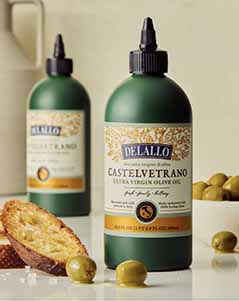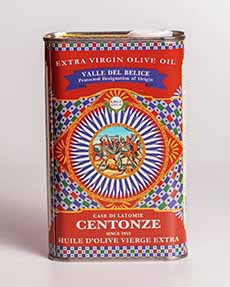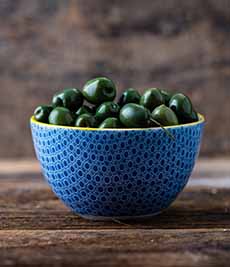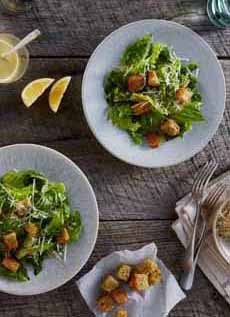|

[1] Castelvetrano EVOO in a handy squeeze bottle is great for drizzling. Buy it here (photos #1 and #4 © DeLallo).

[2] The squeeze bottle option is more flexible than the classic can or bottle. But you might prefer this colorful can for gifting. Note that the can says “Valle del Belice,” where the olives are grown. In the U.S. the olive and oil are known as Castelvetrano (photo © Giadzy).

[3] The bright green color of Castelvetrano olives from an olive bar. When they are packed and sterilized in jars, as opposed to loose in a tub at retail like the ones above, the deep green color fades to a conventional shade of green (photo © diBruno Bros.).

[4] For a delicious snack, side or topping, sauté whole Castelvetrano olives with cherry tomatoes and garlic cloves, in Castelvetrano EVOO.

[5] The flavors make a delicious bread dipper (photo © California Olive Ranch).

[6] Enjoy the flavor on bruschetta and crostini [the difference] (photo © Vitalina Rybakova | iStock Photo).

[7] Great olive oil makes any salad taste better. Above, Caeser salad. Here’s the recipe (photo © Safe Eggs).
|
|
Castelvetrano is a commune in the Valle del Belice, in western Sicily, where Castelvetrano olives are grown and traditionally salt-brined or pressed into olive oil.
Valle del Belice is the home of the Castelvetrano cultivar*, and most of the world’s Castelvetrano olive trees are found in western Sicily.
Western Sicily has one of the finest olive-growing climates in the Mediterranean, with hot days, cool evenings, and coastal breezes.
In Italy and the rest of the European Union, the extra-virgin olive oil is called Valle del Belìce. The table olive and the tree on which it grows is called Nocellara del Belice.
Both Valle del Belice olive oil and Nocellara del Belice table olives have a protected designation of origin (P.D.O.) status in the E.U.
These olives are marketed as Castelvetrano in the U.S. and elsewhere. Why the name change, we have not yet discovered.
THE APPEAL OF CASTELVETRANO OLIVES & EVOO
Over the past few years, these large, meaty, buttery/creamy, nutty, toothsome, and mild olives have become one of the most sought-after varieties. They are subtly briny and have a low salt content compared to other olives.
In addition to pressing for olive oil, Castelvetrano’s great flavor and texture make it a very popular table olive. (In the trade, an olive variety that is delicious for both oil and table is known as a dual-purpose olive.)
The mildness gives Castelvetrano great appeal to many Americans.
Many of us grew up with blander canned olives, used in salads, on pizza toppings, meat loaf, on a relish tray, etc.
Most imported olives and artisan California olives are pungent and briny, a high-impact taste compared to big supermarket olive brands like Del Monte, Goya, and Lindsay.
The bright green color also contributes to the allure.
The Harvest. Like most green olives, Castelvetranos are harvested young, when they reach peak flavor and have bright a green color. The harvest usually takes place from late September through October.
Olive Oil. For EVOO, the olives go directly from the grove to the olive press and produce a richly-colored olive oil with a pale green cast.
Table Olives. The table olives leave the grove for a meticulous curing process: multiple rounds of processing in a fresh water and lye solution, over a span of two weeks.
This process serves two important purposes: It removes the olives’ natural bitter compounds and maintains their crispness and meaty texture.
It also contributes to the development of the signature buttery, mild olive flavor [source].
> All about Castelvetrano olives.
> The different types of olives and olive oil: a photo glossary.
> An overview of extra virgin olive oil.
> The history of olives.
> The history of olive oil.
> The different types of cooking oils.
> Check out more great olive oil information below.
ABOUT DELALLO CASTELVETRANO OLIVE OIL
DeLallo’s Castelvetrano Extra Virgin Olive Oil is packaged in a convenient squeeze bottle, inspired by chefs.
Made from 100% premium Castelvetranos, it captures the fresh olive flavor for which the variety is beloved.
Fruity, grassy and pleasantly bitter with a bright peppery finish, EVOO is a terrific condiment for dressing, drizzling and finishing.
Olive Oil 101: Note that when a specific variety of olive and country of origin is not specified on the label, an EVOO can be made with any type of olives—whether one variety or a blended of varieties, from any country or region.
Extra virgin olive oil made with the first cold press of olives. Here’s more about it.
> Get your DeLallo Castelvetrano Extra Virgin Olive Oil here.
WAYS TO USE CASTELVETRANO OLIVE OIL
Delicious as a salad oil and a finishing oil, this versatile EVOO is a superior everyday cooking oil perfect for sauteing, searing, pan-frying, roasting and even baking.
The squeeze bottle makes it easy.
Baking. Use in recipes for homemade breads, cakes and cookies. Here’s how.
Bread. Use as a bread dipper, and on crostini, bruschetta, and sandwiches: Italian submarine sandwiches.
In fact, try it on any sandwich instead of butter.
Breakfast. Drizzle over plain or vanilla yogurt for flavor and heart-healthy benefits.
Cooking. Use an everyday cooking oil in sautés, pan-fries, and other recipes.
Dessert: Drizzle over ice cream and lemon sorbet.
Garnish. Drizzle in the center of hummus and soups.
Mains. Drizzle it on grilled/roasted meats, poultry, seafood, and vegetables.
Pasta. Use it as a sauce for pasta like Cacio e Pepe—just EVOO, Parmesan, and fresh-cracked pepper.
Or, make pesto (recipe).
Salad. Make your favorite vinaigrette or drizzle directly onto sliced tomatoes or a Caprese salad[4].
MORE ABOUT OLIVE OIL
The Aromas & Flavors Of Olive Oil & The Olive Oil Tasting Wheel
Baking, Grilling & Cooking With Extra Virgin Olive Oil, Plus Recipes
Bake With Olive Oil Instead of Butter
Beware Of Fake Italian Olive Oil
Check your Extra Virgin Olive Oil I.Q.
The Different Flavors Of Olive Oil
Food Fun: An Olive Oil Martini Recipe
Extra Virgin Olive Oil: An Overview
Glossary Of Olive Oil Types & Terminology
Healthy Fats For Cooking & Eating
How To Taste Olive Oil (And Have A Tasting Party!)
Twenty Ways To Use Flavored Or Infused Olive Oils
Why You Should Replace Butter With Olive Oil
OLIVE HOLIDAYS
National Olive Day is June 1st.
World Martini Day is June 15th.
Extra Virgin Olive Oil Day is September 30th.
________________
*A variety is a naturally occurring genetic variation within a species. A cultivar is developed by breeders to possess desirable traits.
|








